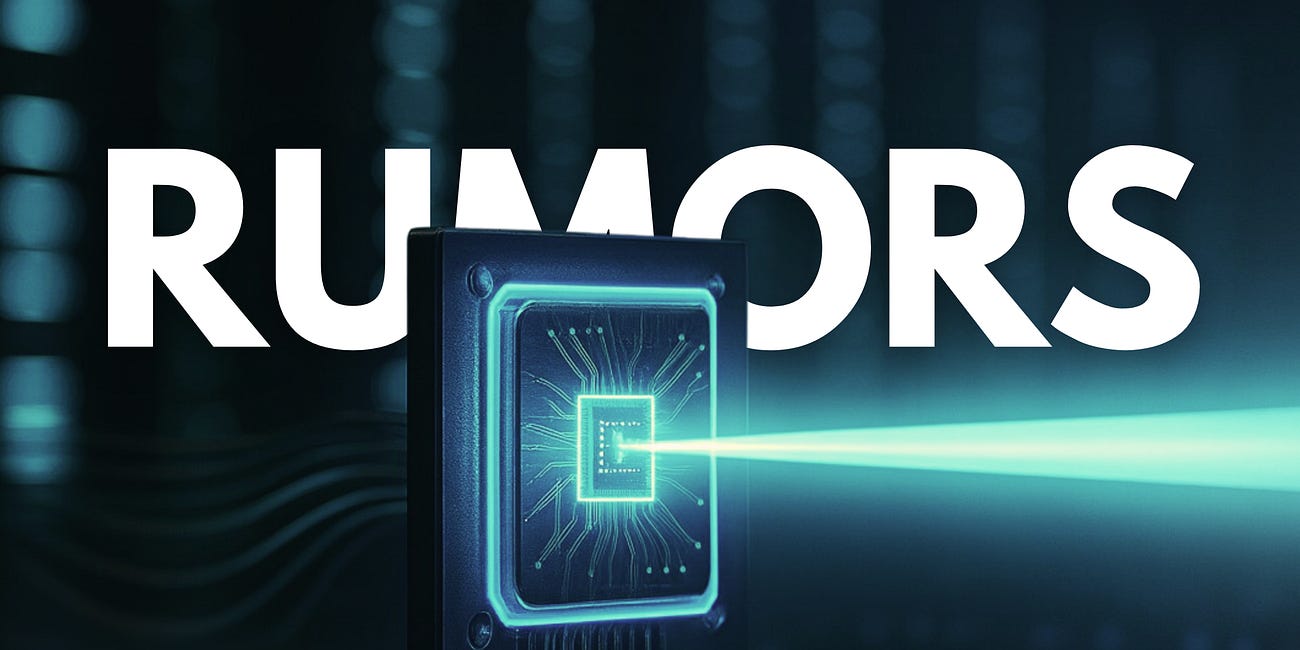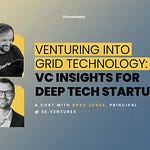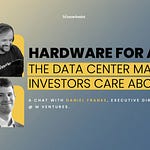Welcome to the 94th edition of Deep Tech Catalyst, the educational channel from The Scenarionist where science meets venture!
Energy in cities is shifting from one-way grids to multi-participant systems. Buildings are becoming energy assets, storage is local, and orchestration is required.
The opportunity is massive, but execution depends on clarity around the moat, repeatable scale in fragmented markets, and the bar for investability at the bits-and-atoms edge.
To unpack the playbook, we’re joined by Moritz Jungmann, Partner at Future Energy Ventures!
In this edition, we dive into:
What a smart city really means through an energy-native lens—buildings as power units and software as the orchestrator
Where the moat actually lives: pure software vs. asset-backed strategies across trading, financing, and control
Business models that scale: interoperability, OEM partnerships, and financing structures that protect 80–90% software margins
Security and resilience in distributed systems: local storage, offline controllers, and risk containment
What “investable” looks like from late seed to Series B: returns, customer cohorts, and leadership maturity
Let’s get into it! 🔋
✨ For more, see Membership | Deep Tech Briefing | Insights | VC Guides
BEYOND THE CONVERSATION — STRATEGIC INSIGHTS FROM THE EPISODE
From Centralized Grids to Decentralized Cities
For most of the last century, power flowed one way. Large plants generated electricity and pushed it across networks to commercial districts, factories, and homes.
The energy transition is dissolving that architecture. As renewable assets proliferate, cities are moving toward a many-participant system in which generation happens on rooftops and sites, storage is local, and coordination shifts to software.
In that setting, a smart city is not a showcase of gadgets—it is an integrated energy ecosystem.
A single building can produce power through rooftop PV, small wind, or geothermal, depending on local conditions. It can pair that generation with a storage unit. And with the right software, it can orchestrate self-consumption, feed energy back to the market, or provide flexibility to the grid.
The core idea is simple but profound: every asset can behave like a mini utility, and the city becomes a network of these units operating in concert.
From Passive Users to Active Participants
As more assets come online, the participant base expands.
Households, commercial sites, and industrial facilities no longer sit at the end of the line; they become prosumers that generate, store, and contribute. The result is a system defined less by central command and more by reliable coordination across thousands of nodes.
Value emerges from how effectively these nodes are integrated, how information flows between them, and how their combined behavior supports stability while unlocking new economic options for each participant.
What “Smart City” Means Through an Energy-Native Lens
Viewed through an energy-native lens, smart means orchestrated.
Software aligns local objectives with system needs, enabling owners to optimize for self-consumption when that makes sense and to participate in markets when it does not.
Storage provides the flexibility necessary to manage intermittency and price volatility.
Local generation reduces exposure to wholesale dynamics and policy shocks.
Put together, this is a pathway to cleaner, more resilient urban energy—one capable of scaling as electrification spreads across buildings, mobility, and industry.
The Optical Interconnect Rush: Powering the New AI Network Stack | Rumors
Six Startups, One Rumor. A new generation of photonic technologies is rewiring data‑center networks for the AI era—at light speed and with radical efficiency.
Europe’s Status Quo: Cost Curves and Urban Drivers
A fully electrified city is not today’s reality. Energy is woven into long-lived infrastructure, and change follows infrastructure timelines. What has shifted is the cost and incentive landscape.
Prices for renewable equipment have declined sharply, pushed by global manufacturing scale and aggressive expansion from Chinese suppliers.
At the same time, end-user power prices have risen, influenced by market dynamics, supply disruptions tied to conflicts, and policy measures that favor low-emission generation. Together, these forces drive a clear commercial case for bringing generation and storage on-site.
Residential, Commercial, and Industrial Sites
The most visible acceleration has been residential solar, supported by subsidies and programs that simplified adoption.
Commercial and industrial sites are following as economics improve. Grid operations, however, are still catching up. Distributed system operators were designed for a one-way model and now must accommodate assets they do not control, injecting power back into the network.
The immediate need is transparency—knowing what is installed, where flows are occurring, and how distributed resources interact with legacy infrastructure.
Why Mass-Market Onboarding Still Lags
Attractive paybacks alone don’t deliver mass adoption. Processes remain fragmented, rules differ by country, and coordination gaps slow the journey from decision to deployment.
Cities concentrate both consumption and emissions, making urban areas the primary arena for progress.
The work now is execution: turning today’s declining hardware costs and stronger price signals into simple, repeatable onboarding so participants can connect quickly while operators gain the visibility required to keep the system stable.
Where the Moat Actually Lives
In energy, B2B software looks attractive on paper—high gross margins, fast replication, and clean scaling. The reality is more interdependent.
Optimization software depends on the existence and density of renewable assets. Without enough deployed generation and storage, there is little to optimize or trade.
That is why many credible offerings pair software with a strategy for ensuring access to assets, whether through customers’ owned equipment or through assets that the company finances and operates.
The current excitement around storage trading illustrates the point. Returns look strong today, but as battery capacity floods the market, trading margins will compress. If the business sits only on the trading layer, it risks being outcompeted as spreads narrow and more players enter.
Owning or financing an asset park—directly or via structured vehicles—can change the game. Control over dispatchable capacity creates leverage in market access, protects against rapid replacement, and supports a more defensible position when trading becomes crowded.
The question a founder must answer is not whether software is valuable, but where the moat comes from once markets become efficient.
Defensibility depends on stickiness. If your platform works with many types of equipment, storage, and market gateways, it’s harder to rip out.
The more it’s wired into on-site machines and market connections, the higher the switching costs—and the harder it is for competitors to copy. This matters even more as AI lets rivals clone features fast. Real protection isn’t just algorithms; it’s being embedded: the data pipes, control permissions, and operating duties that take time and trust to build.
Business Models at the Intersection of Software and Hardware
Consider the common battery case for commercial and industrial sites.
One approach is to sell a software service that manages trading and on-site optimization while the customer purchases the battery outright.
The alternative is to secure space on the customer’s premises, deploy the battery through your own vehicle, and operate it on their behalf.
Both models can deliver value. The difference is in control and replaceability.
If the relationship rests solely on software layered over a customer-owned asset, the barrier to switching is lower. When the operator controls the asset and the dispatch, the position becomes harder to dislodge, particularly as market conditions shift and revenue streams evolve.
OEMs, Bankable Assets, and Financing Structures
Defensibility improves when software is embedded across heterogeneous equipment and tied to bankable hardware. Solar remains straightforward to finance; storage is catching up as data accumulates, but it still commands different terms.
Structuring matters.
Separating the technology company from the asset vehicle can preserve high software margins while unlocking lower-cost capital for deployments. OEM relationships can accelerate interoperability and reduce integration friction, but the strategic aim is the same: maintain the technology layer as the orchestrator while ensuring dependable access to capacity.
What Great Unit Economics Look Like
On the technology side, the target remains classic software economics. Gross margins in the range of 80 to 90 percent signal a clean, scalable model.
That requires a clear separation between what the customer pays for the software and how the assets are financed and operated.
The software contract should stand on its own merits—control, optimization, market access—while the asset platform, whether owned directly or via partners, follows a financing logic that does not dilute the margin profile of the core product.
What “Investable” Looks Like from Late Seed to Series B
Late Seed: Proof That Customers Care (and Pay)
Here, the essential question is whether product–market fit exists in practice, not just in narrative. That shows up as real revenues and a coherent cohort of customers who look alike, behave alike, and provide consistent feedback.
Contracted ARR matters at this stage because it demonstrates intent and durability, but the evaluation doesn’t stop at signatures.
The emphasis is on repeatability: a go-to-market motion that can be executed again, in the same segment, with the same economics. When that pattern is present, capital can help accelerate rather than subsidize discovery.
Series A: Live ARR and Readiness to Scale
By Series A, the bar moves from contracted to live ARR—cash received for a service that is already operating.
The company may still be lean and founder-heavy, with few C-level hires and limited managerial depth. That is acceptable if the revenue engine is functioning and the unit economics are clean.
The focus turns to whether the company can absorb scale: onboarding velocity, integration reliability, and the ability to reproduce deployments without bespoke work. Where revenues are live and the motion is repeatable, the next dollars go into building the team and systems that carry growth.
Series B: Durable Recurrence and Leadership Maturity
At Series B, the expectation is a step-change in organizational and commercial maturity.
Recurring revenues in the range of €5–10 million signal that the product has moved beyond early adopters and that the sales, delivery, and support functions operate as a system.
Leadership depth becomes part of the diligence: can the company run multiple workstreams in parallel—market expansion, product roadmap, partnerships—without losing operational discipline?
Deep Tech Monthly in Review - September 2025
Field Notes from The Scenarionist. A Strategic Recap for Builders and Backers.












